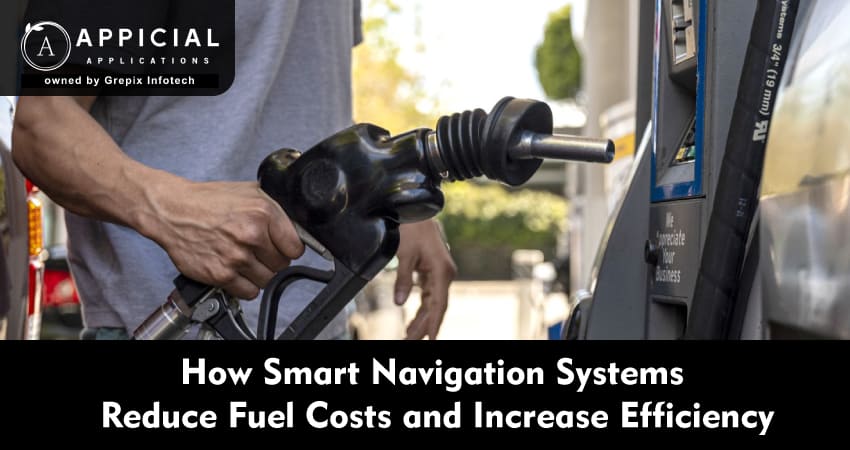
How Smart Navigation Systems Reduce Fuel Costs and Increase Efficiency
Under the age of mobility platforms, every fuel drop, every trip minute, and every driver decision matters. An e-hailing, ride-hailing, or ride-sharing app must not depend on conventional GPS routing. Predictive analytics and smart navigation technologies based on telematics and real-time data are becoming essential for improving fuel economy, vehicle utilisation, and service reliability.
For companies wishing to create or grow an Uber Clone/white-label taxi solution, the association with an efficient white-label taxi app development company or a taxi app development company that offers smart navigation modules is no longer a choice but a strategy. This blog delves into why smart navigation matters, how to implement it, the measurable benefits, and how you can leverage it in your platform.
This blog explores in depth how smart navigation systems help reduce fuel costs and increase operational efficiency for ride-hailing and ride-sharing platforms. We examine what smart navigation means, why it matters for a ride-hailing app or e-hailing app, how it benefits operators, key implementation factors, challenges, data and stats, and how a taxi app development company can integrate these features into a white label taxi booking app or Uber Clone solution. The conclusion promotes Appicial Applications and includes a call to action..
What Exactly Are Smart Navigation Systems?
Definition and Key Components
Smart navigation systems are more than maps with turn-by-turn directions. They integrate the information of the GPS, traffic data in real time, telematics of the vehicles (fuel used, time of idling, driver behaviours), and algorithms of prediction to suggest avoid the waste of time and fuel and doing the most efficient routes. Studies show that fleets with route optimisation tools can save upwards of 15% in fuel costs.
These systems also monitor driver behaviour (such as harsh braking or idling) and integrate with analytics to continuously refine patterns. For a ride-sharing app or ride-hailing app, this means the navigation engine is smart, adaptive and efficient.
Why They Matter in Ride-Hailing and E-Hailing Apps
When using an e-hailing app or Uber Clone, map navigation is more than simply point A to point B. It’s about maximising efficiency in each ride, minimising deadhead time, minimising deadhead distance, and having driver supply and rider demand meet more effectively in a dynamic way . The profitability is ensured through a smart navigation help, drivers save on fuel, and users experience a better service in terms of pick and drop-off times.
Role of a Taxi App Development Company
When building a platform via a taxi app development company or collaborating with a white label taxi app development company, the navigation module must be integrated at the core. That means the dispatch engine must compute optimal routes, the driver app must present fuel-efficient paths, and the backend must collect data on fuel usage, route deviations and performance. The navigation layer becomes a fundamental part of your white label taxi booking app architecture.
Why Do Smart Navigation Systems Reduce Fuel Costs?
Route Optimisation and Real-Time Adjustments
Smart navigation cuts out wasted time in traffic or detours. For example, one Australian fleet using smart GPS routing reduced fuel usage by over 12 % in six months. By choosing optimal paths, the system reduces kilometres driven and idle time. Idle time is a major contributor to fuel waste. According to a report, vehicles using telematics and route optimisation can achieve up to 20 % better fuel efficiency. In a ride-hailing context, every minute a driver is cruising or waiting for fuel, it is being consumed without revenue gained.
Monitoring Driver Behaviour and Reducing Fuel-Wasting Habits
Beyond routing, smart navigation systems monitor driver behaviours such as sharp acceleration, braking, excessive idling or speeding. These behaviours raise fuel consumption by up to 15-30 % according to some studies. By identifying and addressing these behaviours via real-time alerts or coaching, a ride-hailing app can promote fuel-efficient driving across its driver base.
Aligning Supply and Demand More Efficiently
With smart navigation, the platform has better insights on expected trip durations, distances and idle times. A ride-sharing app using advanced navigation data can reduce driver dead mileage (travelling without a passenger) by optimising dispatch assignments. Less dead mileage means less wasted fuel and higher driver productivity. This is especially important for a scalable Uber Clone or white label taxi booking app looking to maximise fleet utilisation.
Predictive Maintenance and Avoiding Fuel Inefficiencies
Smart navigation systems integrate with telematics and vehicle diagnostics. They flag vehicles operating sub-optimally (e.g., low tyre pressure, engine faults), which can degrade fuel economy. According to fleet management research, implementing telematics and maintenance monitoring can reduce fuel and maintenance costs by 16 % or more. For a taxi app development company, ensuring vehicle-health data flows into routing and assignment logic improves efficiency.
Environmental Benefits and Cost-Savings Synergy
Less fuel consumption equals fewer emissions, something that appeals to the contemporary user and regulator. Portraying a platform as efficient and green can also help build trust, and thus foster adoption, in ride-hailing companies. It would further tie to controlling costs; less fuel used means improved margins across an e-hailing app.
How Do Smart Navigation Systems Increase Efficiency Beyond Fuel Savings?
Reduced Driver Idle and Waiting Time
Smart navigation helps reduce the time drivers spend waiting for rides or being routed inefficiently. When routing and dispatch are aligned, driver downtime drops. More trips per shift mean higher earnings for drivers and lower cost per ride for the platform.
Improved On-Time Performance and Customer Experience
As no sliding occurs, wait times are reduced and service is reliable. Reliability is a competitive advantage for a ride hailing app. This leads to increased retention and referrals given better ETAs, less cancellation risks, and user satisfaction.
Optimised Fleet Utilisation and Matching
Smart navigation gives the backend visibility into anticipated availability, estimated trip durations, upcoming idle windows and driver positioning. A white label taxi booking app built with such capabilities ensures each vehicle is used effectively, reducing fleet wasted hours and increasing return on investment.
Lower Maintenance and Operating Costs
Driving efficiently and taking optimal routes also reduces wear and tear on vehicles. Fewer harsh accelerations, fewer long idle times, fewer unnecessary starts and stops reduce engine strain and maintenance needs. According to industry data, better routing and vehicle monitoring can lower not only fuel costs but also maintenance and labour costs by significant percentages.
Scalable Operations and Growth Readiness
As a business scales its Uber Clone or e-hailing app, inefficiencies compound. Smart navigation ensures that incremental volume does not lead to proportional increases in cost. The system becomes an enabler of growth rather than a cost drain. A taxi app development company can ensure the architecture accommodates scaling with minimal bump in per-ride expense.
How to Implement Smart Navigation in Your Ride-Hailing Platform?
Select the Right Taxi App Development Company
When building your white label taxi booking app or Uber Clone, choose a taxi app development company or white label taxi app development company that has experience with route optimisation, telematics integration, driver behaviour monitoring, and analytics. Ensure they understand the full stack: driver app, rider app, dispatch engine, navigation engine, data architecture.
Integrate Real-Time Data Sources
Smart navigation requires real-time inputs: traffic data, road closures, weather information, driver location, vehicle telematics, fuel usage and idle time. The ride sharing app must integrate APIs for live traffic and map updates. The system should also ingest telemetry from driver vehicles (or drivers’ mobile devices) to feed back into routing logic.
Build Dynamic Dispatch and Routing Logic
The architecture must treat navigation as an algorithmic service that interacts with dispatch. The engine must weigh multiple variables: driver location, passenger pickup, real-time traffic, estimated distance, idle time, route fuel cost. For a ride hailing app, this logic ensures that the driver chosen minimises fuel and time cost for the platform while offering a good user experience.
Monitor and Analyse Driver Behaviour
Integrate telemetry to monitor idling, hard braking, rapid acceleration, and off-route movement. Use dashboards to highlight inefficiencies. The system should feedback to drivers via the driver app or through coaching programmes. A white label taxi booking app should support driver metrics, gamification and incentives for fuel-efficient behaviour.
Continuous Optimisation Through Analytics
Collect data on route performance, actual vs estimated fuel consumption, idle time, driver performance, and maintenance events. Use analytics to refine routing parameters, update driver training, and adjust dispatch heuristics. A strong taxi app development company will also build A/B testing frameworks for route logic and driver incentives.
User Experience and Driver App Integration
From the driver’s perspective, the navigation interface must be intuitive, reliable, and clear. It should show optimal route suggestions, alert to detours, provide fuel-efficient alternative route options and integrate with dispatch automatically. In the rider app for your Uber Clone, status updates should reflect realistic ETAs derived from the smart navigation backend rather than generic estimates.
Policies and Incentives for Drivers
Tech is not sufficient on its own. The platform has to motivate drivers to select optimal routes and drive in a fuel-efficient manner. Perhaps you would implement reward programs for drivers with the least amount of idle time or average fuel used per trip. The driver dashboard in your ride sharing app must reflect these KPIs.
Pilot, Measure, Scale
Start with a pilot in a subset of your fleet or in a specific region. Monitor key metrics: fuel cost per km, idle time, on-time ratio, driver utilisation, maintenance costs. Once validated, scale across your fleet. The architecture of your e-hailing app built by the white label taxi app development company must support smooth scaling.
Also Read: 5 Reasons Every Ride-Hailing App Needs Integrated Directions APIs
What Challenges Must Be Addressed?
Data Accuracy and Integration
Dynamic navigation requires access to precise and updated information. Routing can be affected by low quality maps, late traffic or absence of telematics data. The dispatch logic for a ride hailing app also needs to be tolerant to latency and errors in data.
Driver Compliance and Behavioural Change
Even the best routing engine fails if drivers ignore optimal paths or revert to habitual behaviour. Enforcing compliance and motivating behavioural change is challenging. A ride sharing app must invest in driver training, monitoring and incentivisation.
Scalability and System Load
As your Uber Clone expands, the volume of route calculations, telematics events and data ingestion grows. The backend must be architected for high concurrency and low latency routing decisions. The taxi app development company must ensure the system can scale without degrading performance.
Edge Cases and Unpredictability
Traffic accidents, sudden road closures, severe weather events or vehicle breakdowns disrupt optimal routing. The system must include fallback logic, buffer times, and alternative driver assignments. The white label taxi booking app needs resilience built in.
Driver Acceptance of Technology
Drivers might resist being monitored, or feel navigation suggestions reduce their autonomy. The platform must clearly communicate benefits—better earnings, less idle time, less fuel wasted and provide an intuitive driver experience.
Cost of Implementation vs ROI
Investment in smart navigation infrastructure (telematics hardware, data licenses, routing engine, development) must be justified by measurable savings. But as the statistics show, many fleets have achieved 12-16% fuel cost reduction, indicating strong ROI potential for a properly built ride-hailing app.
Conclusion
Smart navigation systems are no longer optional extras for mobility platforms; they are foundational to achieving operational efficiency, reducing fuel costs, and delivering a competitive ride-sharing app, ride-hailing app, or e-hailing app. From route optimisation and real-time data to driver behaviour monitoring and analytics-driven dispatch, the benefits are tangible: fleets have reported fuel cost reductions of 12-16% or more, lower idle time, better vehicle utilisation, and improved user experience.
If you are planning to launch an Uber Clone or deploy a branded mobility platform via a white label taxi booking app, make sure you choose a taxi app development company or white label taxi app development company that embeds smart navigation capabilities from day one. One such company is Appicial Applications. With deep expertise in ride-hailing technology, they deliver full-stack solutions, including driver apps, rider apps, dispatch engines, navigation modules and analytics dashboards.
At Appicial Applications, you get:
- A ready-to-deploy Uber Clone with smart navigation built in.
- Integration of telematics, driver behaviour monitoring and fuel efficiency dashboards.
- Scalable architecture designed for growth and efficiency.
- White label ownership so you can brand, customise and own your platform.
- Post-launch support, optimisation and continuous improvement.
Don’t leave fuel costs and inefficiencies to chance. Contact Appicial Applications today to build your next-generation ride hailing or ride sharing app with smart navigation at its core. Get started with a free consultation and bring efficiency, growth and profitability to your mobility business.
FAQs
Author's Bio

Vinay Jain is the Founder at Grepix Infotech and brings over 12 years of entrepreneurial experience. His focus revolves around software & business development and customer satisfaction.
Back to blog list




